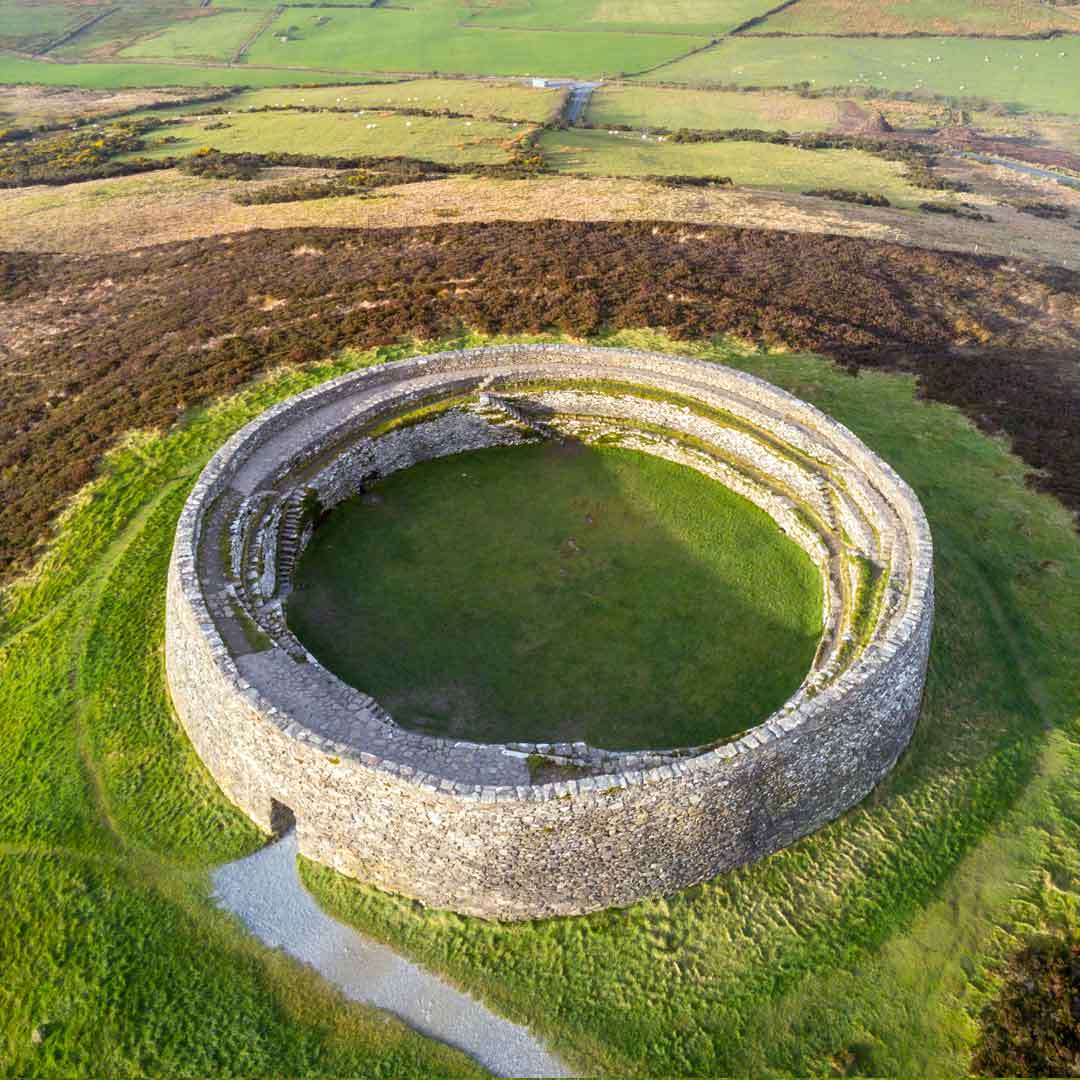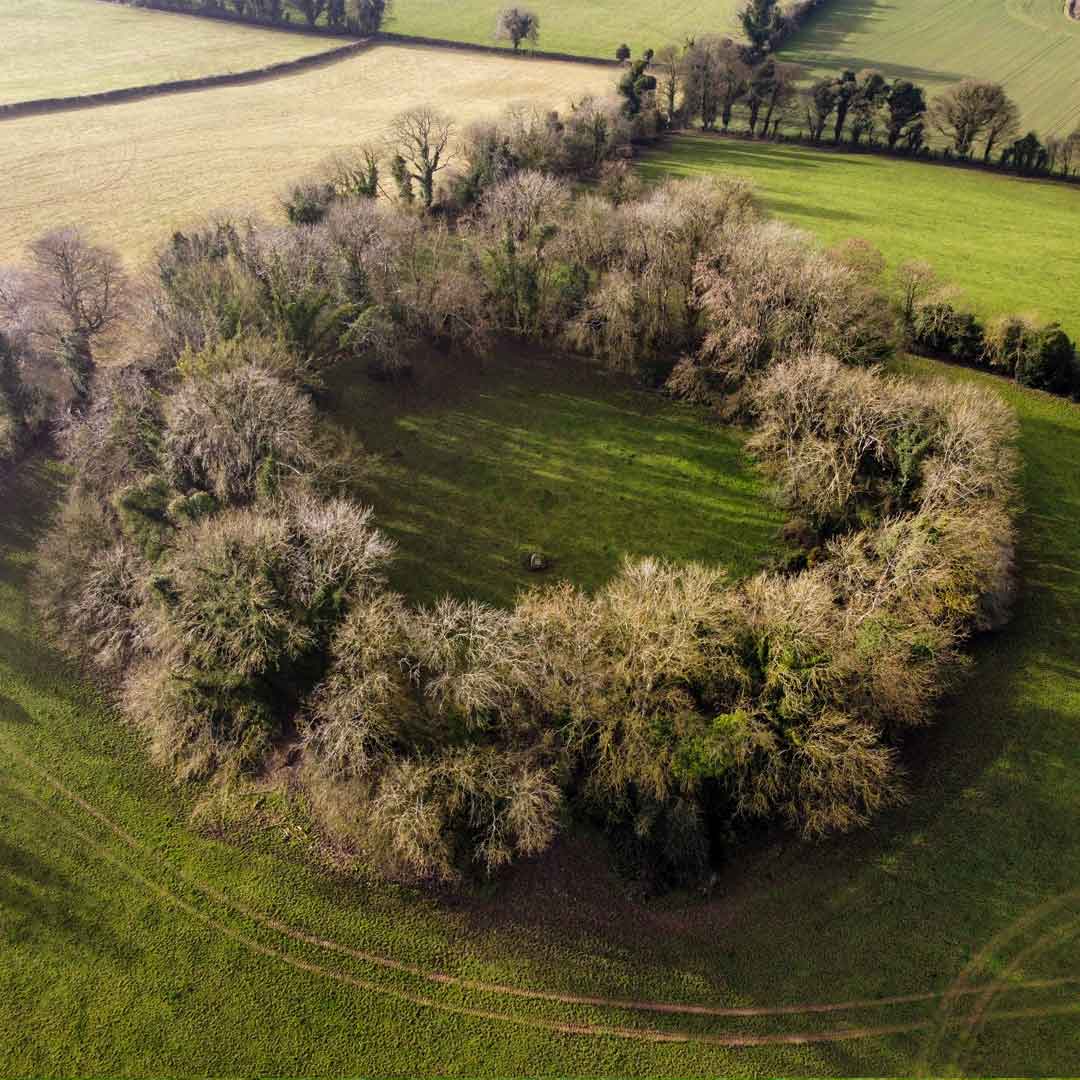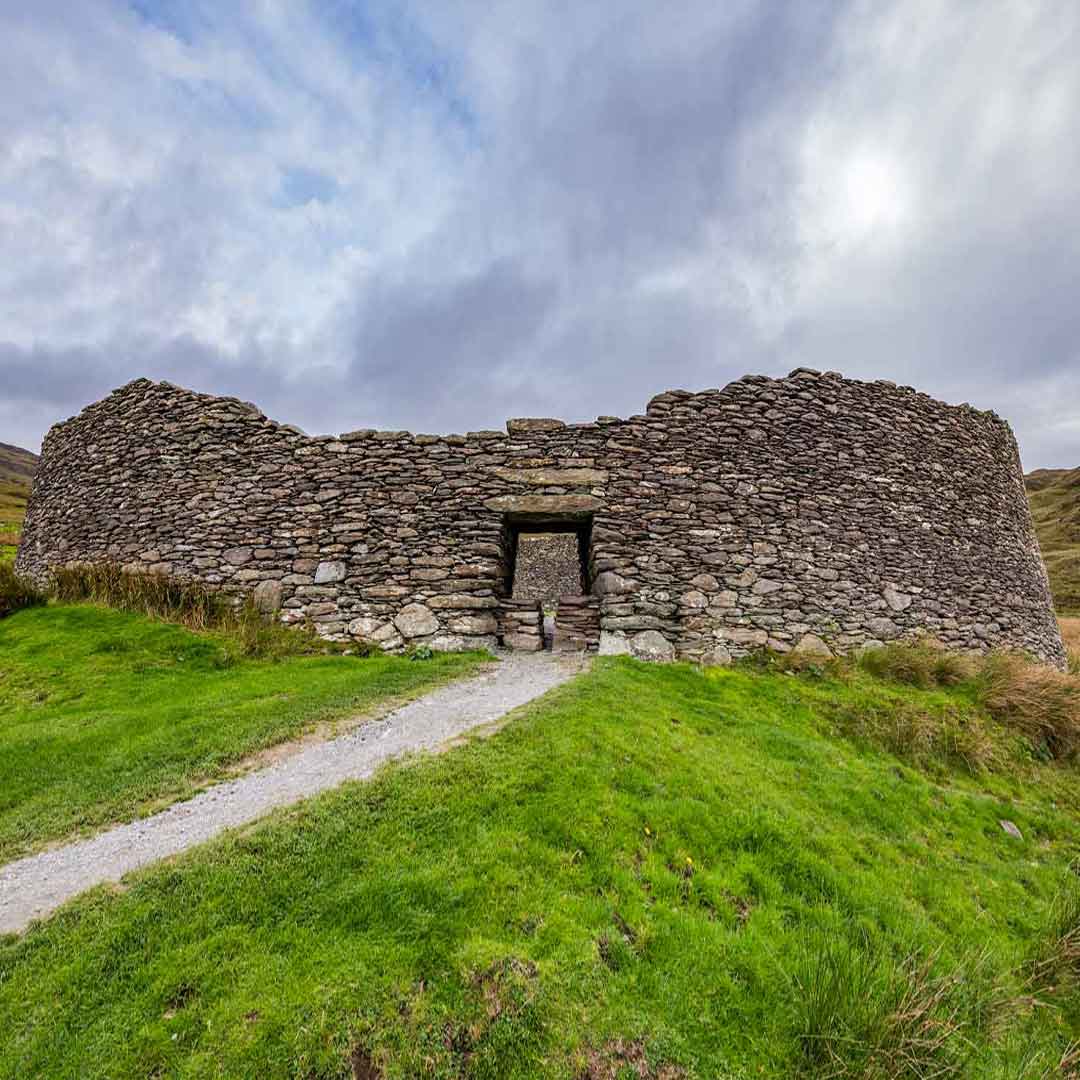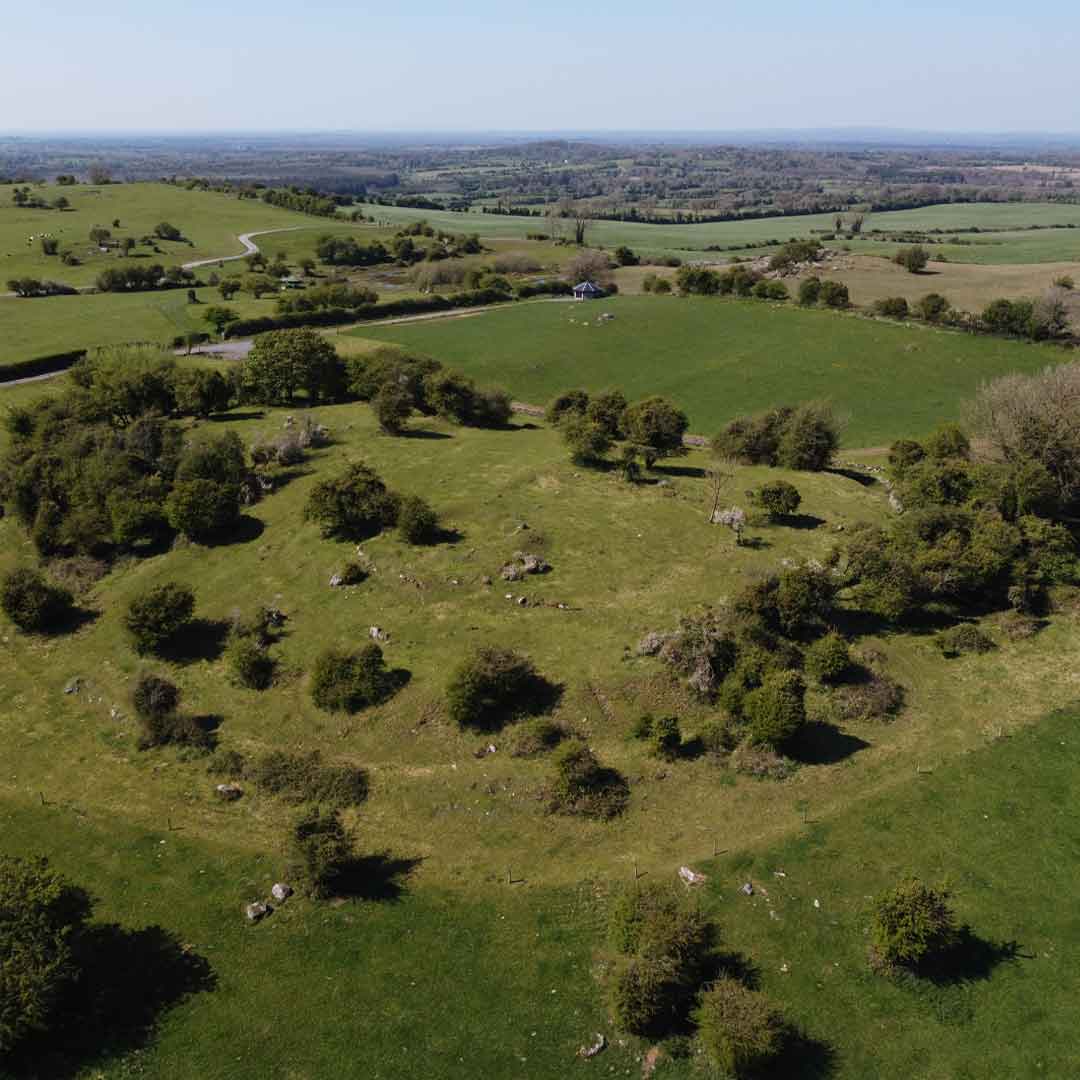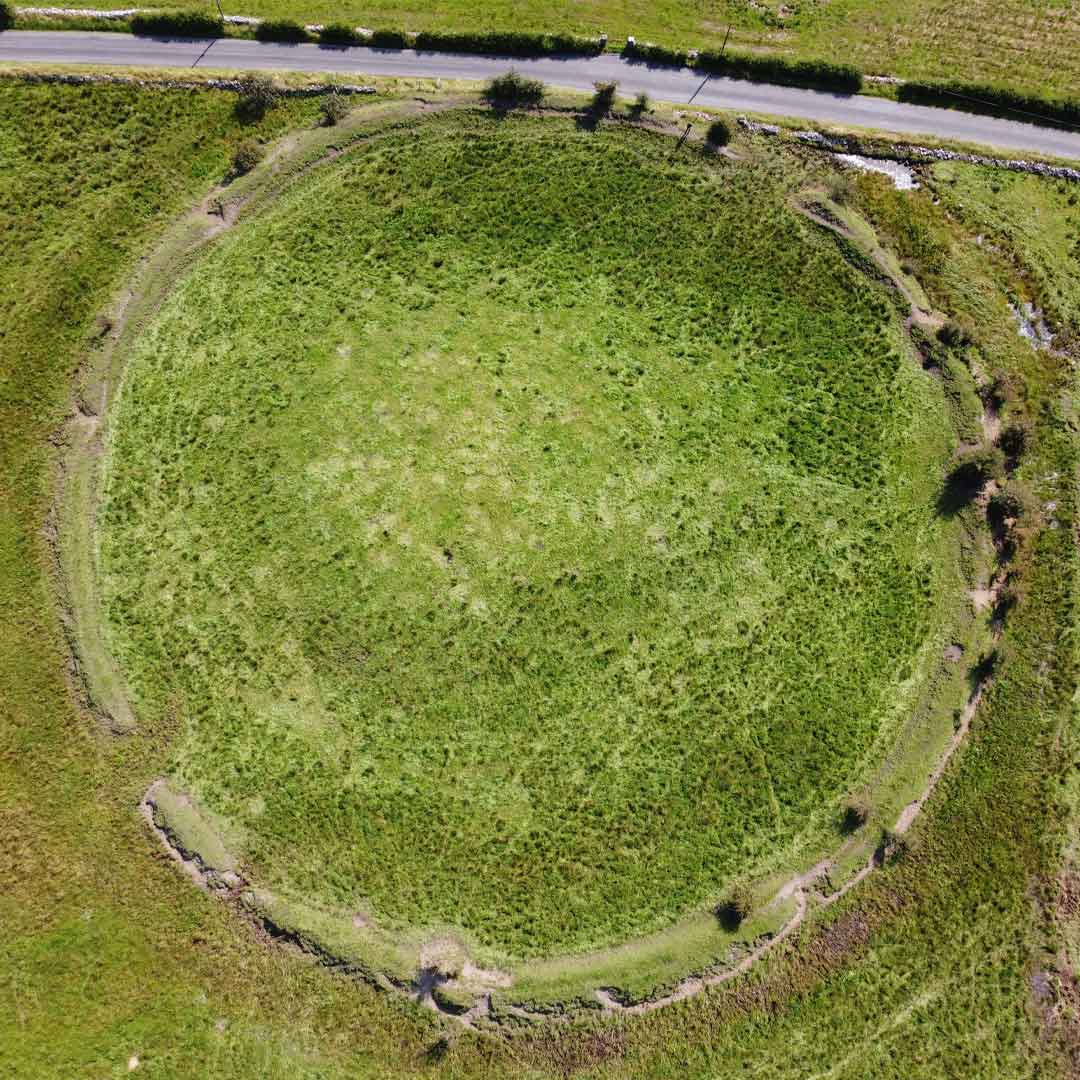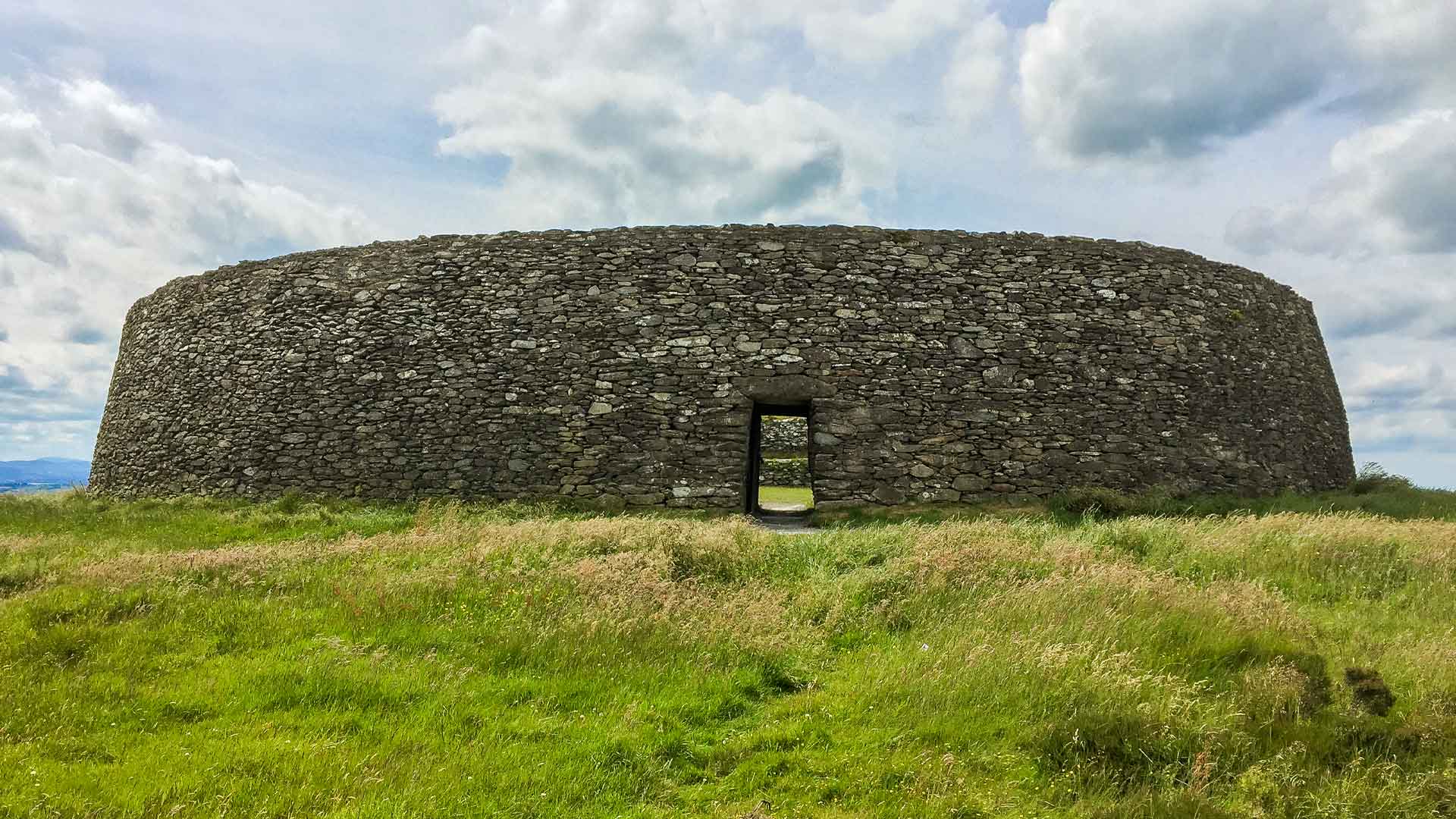
Ringforts
Ringforts are the most common monument surviving in Ireland with up to 60,000 examples spread across the whole of the island. Most were built during the Early Medieval period (c.500-900CE), although some are thought to date to Late Iron Age (c.100-500CE). However many are found on or within earlier sites that have origins going back as far as the Bronze Age (2500-500BC).
Ringforts are circular settlements that come in many sizes and can be made of stone or earth. In the Irish language, they are known by a number of names: Ráth (Rath), Lios (Lis), Caiseal (Cashel), Cathair (Cahir or Caher) and Dún (Dun or Doon). Ráth and Lios are earthen ringforts, Caiseal and Cathair are stone ringforts and the term Dún was usually used for any stronghold of importance, wether it was a ring fort or not.
Many of the towns and villages in Ireland have these terms at the start of their names (e.g. Rathcoole, Lispole, Caherciveen, Cashelmara, Dundalk) as often they were built up around the site of a ringfort.

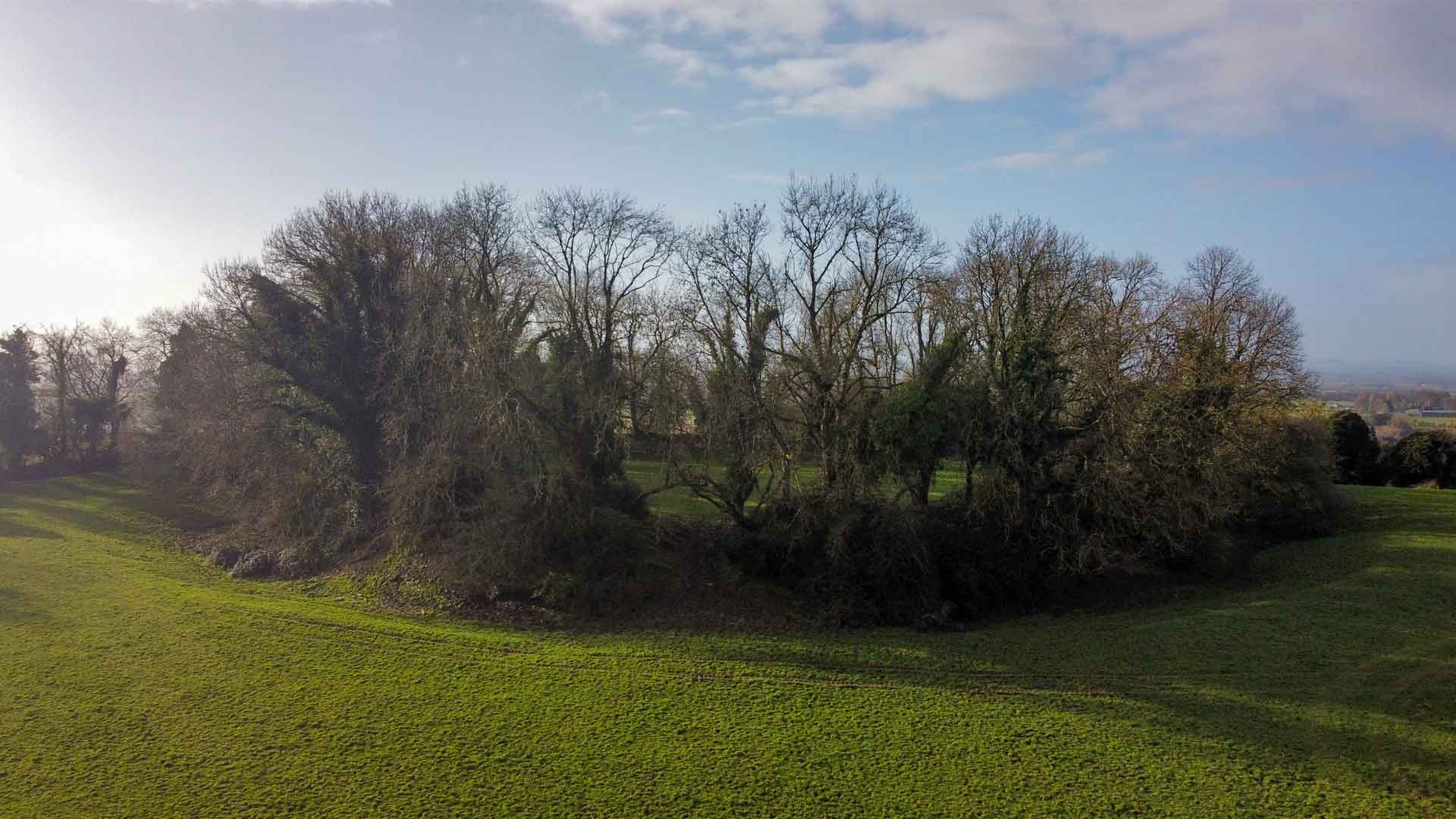
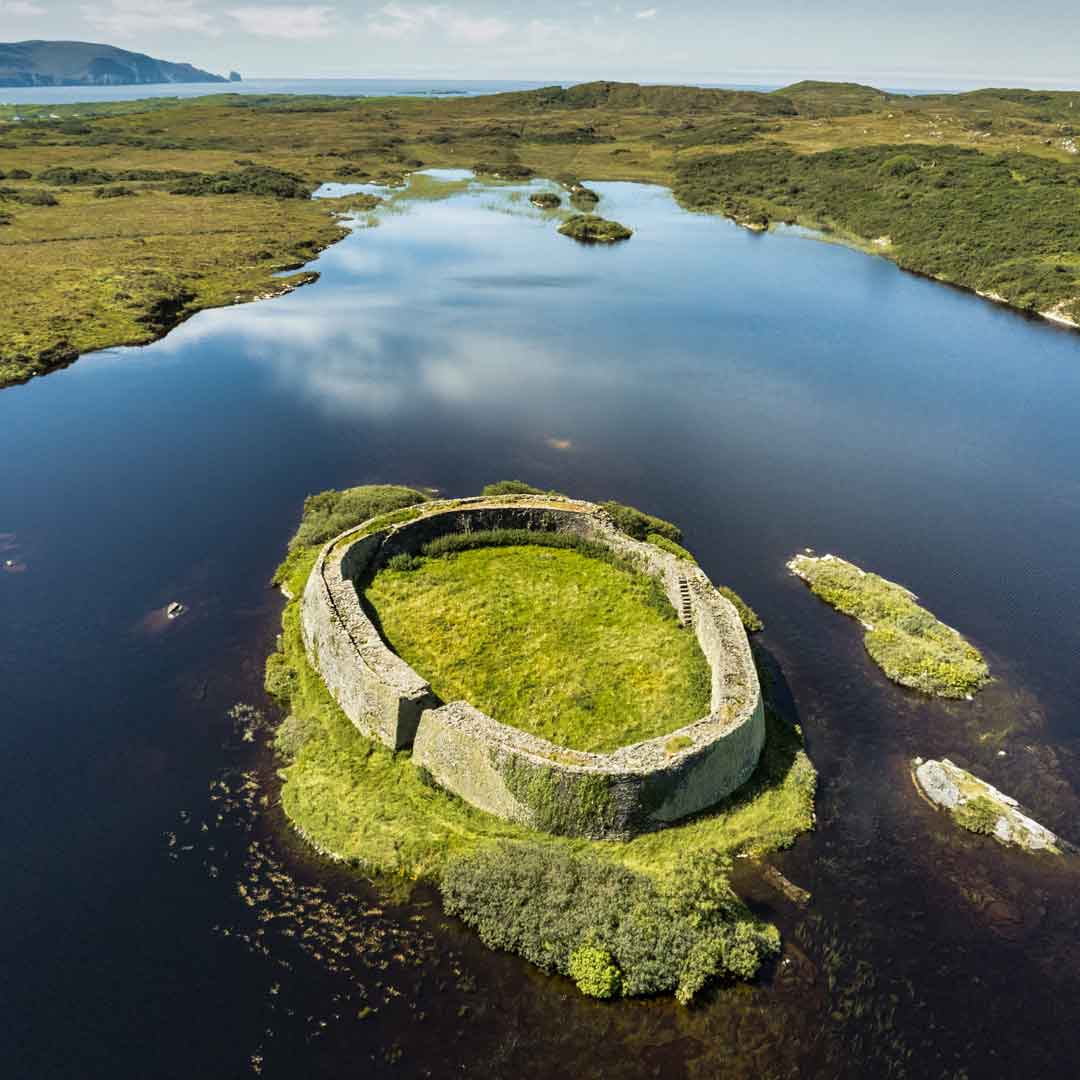
Despite their title, the majority of smaller ringforts are understood to have been farmsteads, homes to free men and their families in an agricultural society dominated by cattle. (however, the term ‘ring-farm’ doesn’t have quite the ‘ring’ to it… excuse the pun). These would have been the homesteads of the majority of the native Irish during the Early Medieval period.
That said, many of the larger ringforts would have been defensive structures. Often situated on top of hills and in sight of other ringforts, they would have provided protection to the small community and their livestock during a cattle raid with the hope that help would come from a neighbouring ringfort - if they weren't the ones doing the raiding.

Beyond their domestic and defensive use however, some ringforts were built for more ceremonial purposes often associated with kingship. Most of the ancient Royal Sites of Ireland have ringforts within their complexes. Some of these royal forts are conjoined (figure of eight) forts, a type unique to the royal sites. The ringforts found at the royal and other ceremonial sites are thought to be some of the oldest in the country.
An explanation for this can be found in the Críth Gablach (an 8th Century legal text): “What is the due of a king who is always in residence at the head of his tuath? Seven score feet of perfect feet are the measure of his stockade on every side. Seven feet are the thickness of its earthwork, and twelve feet its depth. It is then that he is a king, when ramparts of vassalage surround him. What is the rampart of vassalage? Twelve feet are the breadth of its opening and its depth and its measure towards the stockade. Thirty feet are its measure outwardly.”
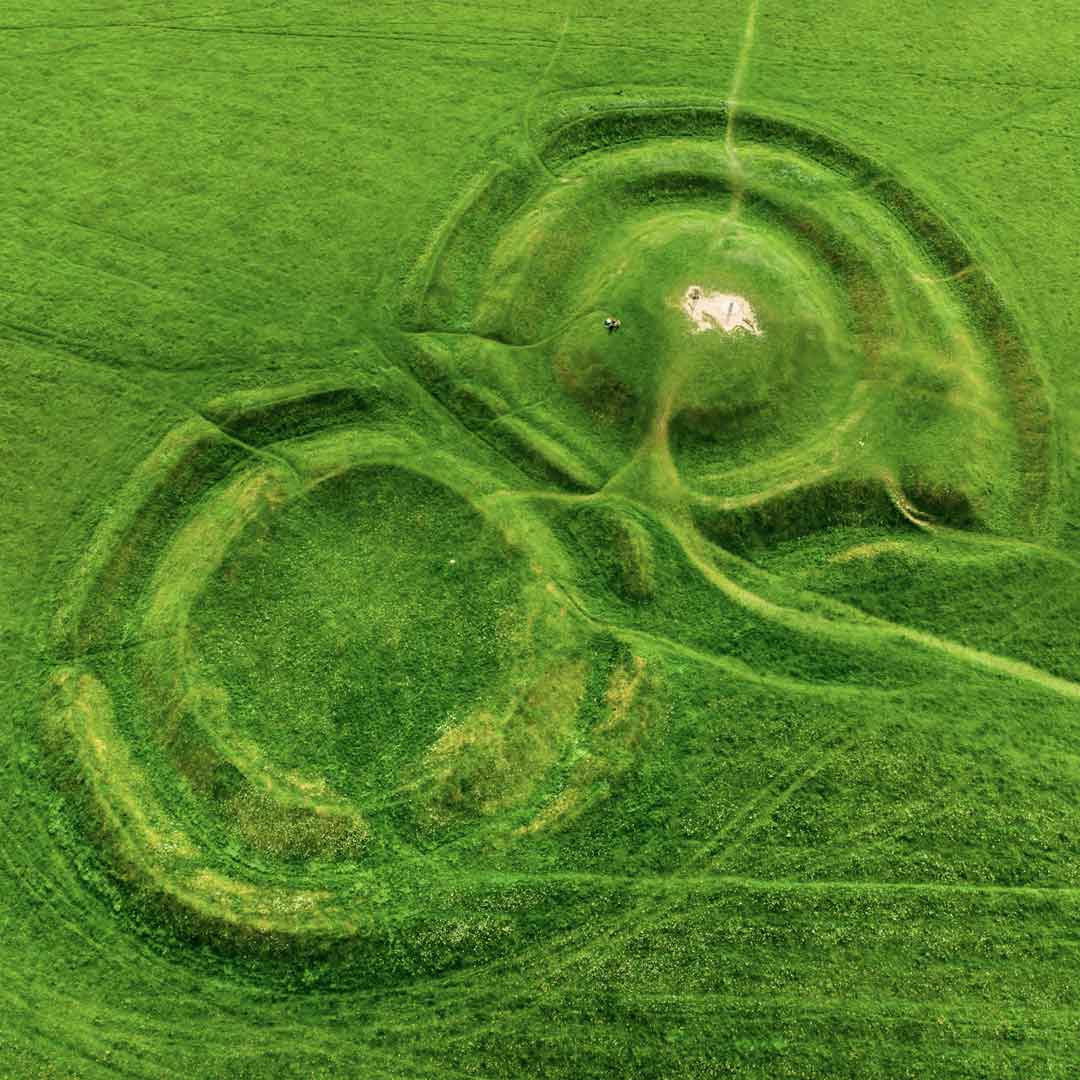
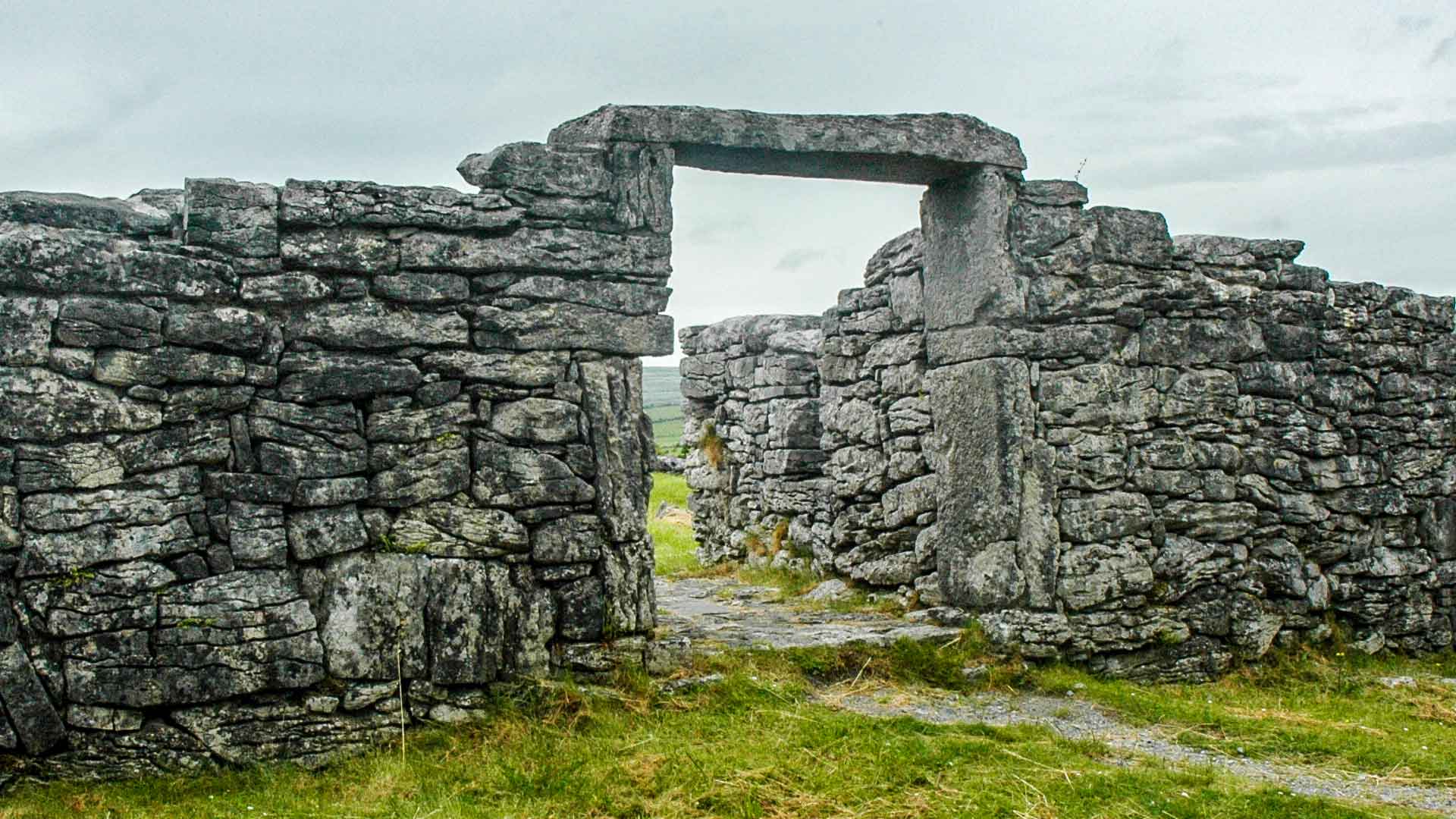
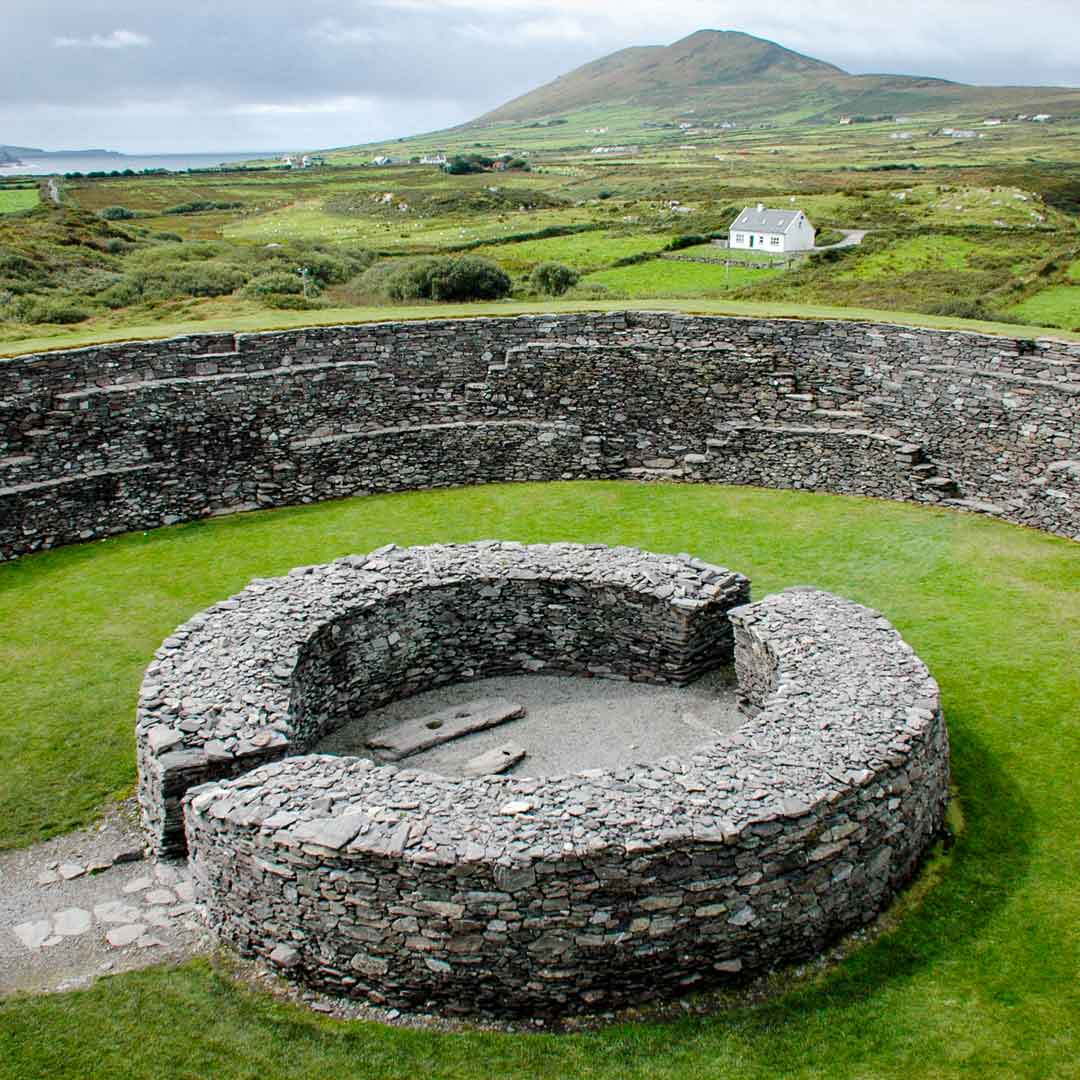
As the majority of ringforts were abandoned during the early centuries of the 2nd millennium AD, these constructions began to disintegrate, leaving their remains dotted across the landscape. Over time these decaying circles came to be associated with the fairies, hence the name ‘fairy forts’ and were very much left alone for fear of offending the supernatural beings thought to reside within them.
Tales regarding the Cahergal and Staigue forts on the Ivereagh Peninsula, Co. Kerry, has it that their fairy inhabitants would compete against each other in hurling matches; often drafting human players to help them win. Similar folklore regarding local ring forts can be found all around the country.
Check out the examples of Ringforts below or click here to view all
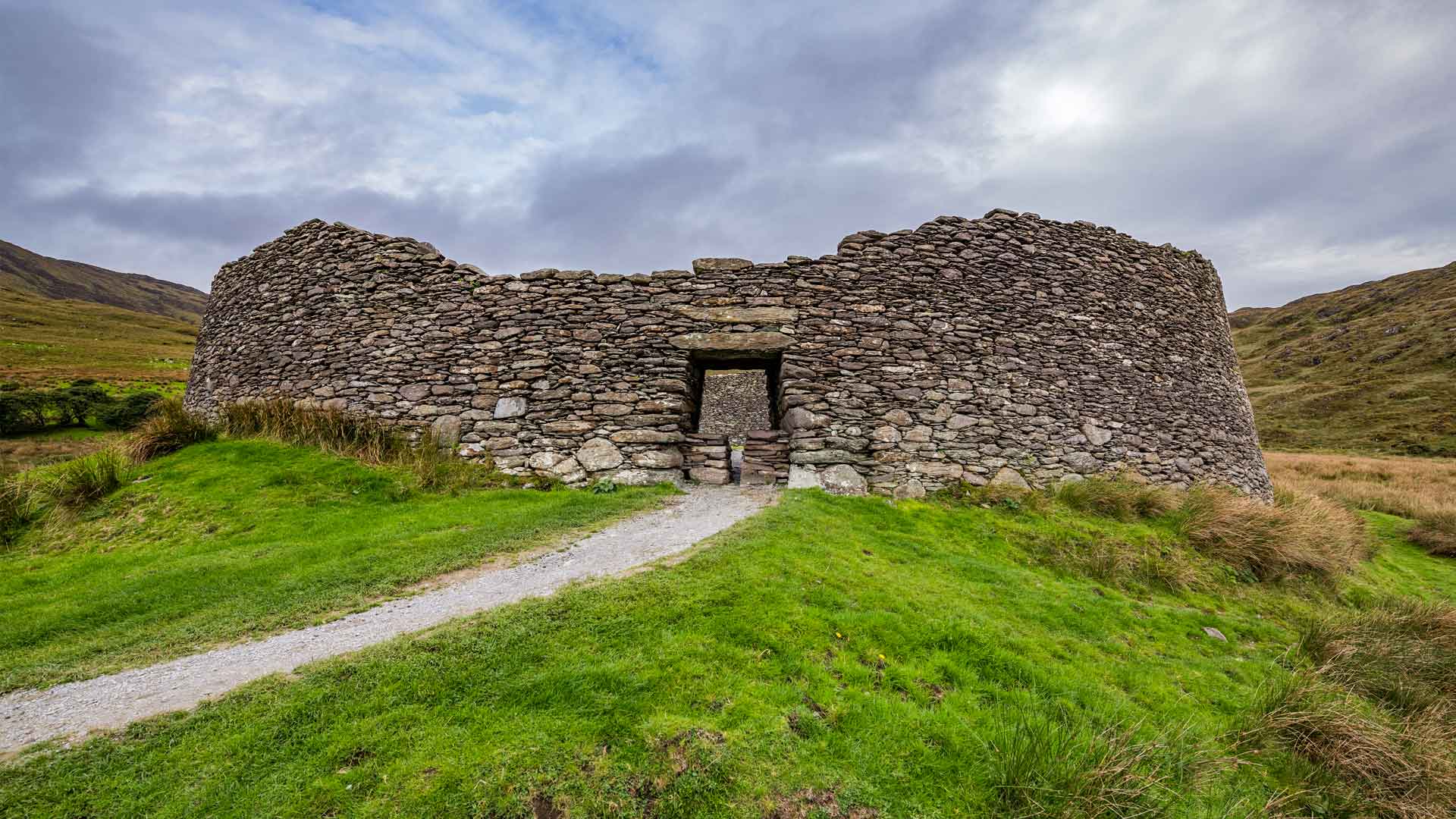
Examples of Ringforts

Ringforts
Ringforts are the most common monument surviving in Ireland with up to 60,000 examples spread across the whole of the island. Most were built during the Early Medieval period (c.500-900CE), although some are thought to date to Late Iron Age (c.100-500CE). However many are found on or within earlier sites that have origins going back as far as the Bronze Age (2500-500BC).
Ringforts are circular settlements that come in many sizes and can be made of stone or earth. In the Irish language, they are known by a number of names: Ráth (Rath), Lios (Lis), Caiseal (Cashel), Cathair (Cahir or Caher) and Dún (Dun or Doon). Ráth and Lios are earthen ringforts, Caiseal and Cathair are stone ringforts and the term Dún was usually used for any stronghold of importance, wether it was a ring fort or not.
Many of the towns and villages in Ireland have these terms at the start of their names (e.g. Rathcoole, Lispole, Caherciveen, Cashelmara, Dundalk) as often they were built up around the site of a ringfort.



Despite their title, the majority of smaller ringforts are understood to have been farmsteads, homes to free men and their families in an agricultural society dominated by cattle. (however, the term ‘ring-farm’ doesn’t have quite the ‘ring’ to it… excuse the pun). These would have been the homesteads of the majority of the native Irish during the Early Medieval period.
That said, many of the larger ringforts would have been defensive structures. Often situated on top of hills and in sight of other ringforts, they would have provided protection to the small community and their livestock during a cattle raid with the hope that help would come from a neighbouring ringfort - if they weren't the ones doing the raiding.

Beyond their domestic and defensive use however, some ringforts were built for more ceremonial purposes often associated with kingship. Most of the ancient Royal Sites of Ireland have ringforts within their complexes. Some of these royal forts are conjoined (figure of eight) forts, a type unique to the royal sites. The ringforts found at the royal and other ceremonial sites are thought to be some of the oldest in the country.
An explanation for this can be found in the Críth Gablach (an 8th Century legal text): “What is the due of a king who is always in residence at the head of his tuath? Seven score feet of perfect feet are the measure of his stockade on every side. Seven feet are the thickness of its earthwork, and twelve feet its depth. It is then that he is a king, when ramparts of vassalage surround him. What is the rampart of vassalage? Twelve feet are the breadth of its opening and its depth and its measure towards the stockade. Thirty feet are its measure outwardly.”



As the majority of ringforts were abandoned during the early centuries of the 2nd millennium AD, these constructions began to disintegrate, leaving their remains dotted across the landscape. Over time these decaying circles came to be associated with the fairies, hence the name ‘fairy forts’ and were very much left alone for fear of offending the supernatural beings thought to reside within them.
Tales regarding the Cahergal and Staigue forts on the Ivereagh Peninsula, Co. Kerry, has it that their fairy inhabitants would compete against each other in hurling matches; often drafting human players to help them win. Similar folklore regarding local ring forts can be found all around the country.
Check out the examples of Ringforts below or click here to view all

Examples of Ringforts

Ringforts
Ringforts are the most common monument surviving in Ireland with up to 60,000 examples spread across the whole of the island. Most were built during the Early Medieval period (c.500-900CE), although some are thought to date to Late Iron Age (c.100-500CE). However many are found on or within earlier sites that have origins going back as far as the Bronze Age (2500-500BC).
Ringforts are circular settlements that come in many sizes and can be made of stone or earth. In the Irish language, they are known by a number of names: Ráth (Rath), Lios (Lis), Caiseal (Cashel), Cathair (Cahir or Caher) and Dún (Dun or Doon). Ráth and Lios are earthen ringforts, Caiseal and Cathair are stone ringforts and the term Dún was usually used for any stronghold of importance, wether it was a ring fort or not.
Many of the towns and villages in Ireland have these terms at the start of their names (e.g. Rathcoole, Lispole, Caherciveen, Cashelmara, Dundalk) as often they were built up around the site of a ringfort.


Despite their title, the majority of smaller ringforts are understood to have been farmsteads, homes to free men and their families in an agricultural society dominated by cattle. (however, the term ‘ring-farm’ doesn’t have quite the ‘ring’ to it… excuse the pun). These would have been the homesteads of the majority of the native Irish during the Early Medieval period.
That said, many of the larger ringforts would have been defensive structures. Often situated on top of hills and in sight of other ringforts, they would have provided protection to the small community and their livestock during a cattle raid with the hope that help would come from a neighbouring ringfort - if they weren't the ones doing the raiding.


Beyond their domestic and defensive use however, some ringforts were built for more ceremonial purposes often associated with kingship. Most of the ancient Royal Sites of Ireland have ringforts within their complexes. Some of these royal forts are conjoined (figure of eight) forts, a type unique to the royal sites. The ringforts found at the royal and other ceremonial sites are thought to be some of the oldest in the country.
An explanation for this can be found in the Críth Gablach (an 8th Century legal text): “What is the due of a king who is always in residence at the head of his tuath? Seven score feet of perfect feet are the measure of his stockade on every side. Seven feet are the thickness of its earthwork, and twelve feet its depth. It is then that he is a king, when ramparts of vassalage surround him. What is the rampart of vassalage? Twelve feet are the breadth of its opening and its depth and its measure towards the stockade. Thirty feet are its measure outwardly.”


As the majority of ringforts were abandoned during the early centuries of the 2nd millennium AD, these constructions began to disintegrate, leaving their remains dotted across the landscape. Over time these decaying circles came to be associated with the fairies, hence the name ‘fairy forts’ and were very much left alone for fear of offending the supernatural beings thought to reside within them.
Tales regarding the Cahergal and Staigue forts on the Ivereagh Peninsula, Co. Kerry, has it that their fairy inhabitants would compete against each other in hurling matches; often drafting human players to help them win. Similar folklore regarding local ring forts can be found all around the country.
Check out the examples of Ringforts below or click here to view all



